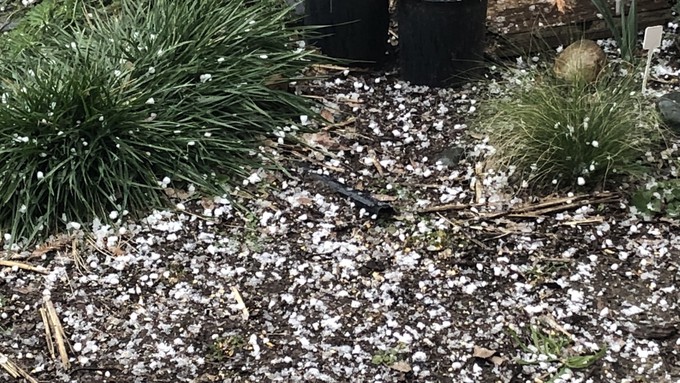
Unusual cold weather inspires some meteorological education

Graupel accumulates on soil and plants Wednesday in northern Carmichael. Kathy Morrison
The white stuff falling from the sky looked like hail, but it didn't bounce. When I picked it up, the little pellets were soft and mushy, not hard. It didn't seem to be snow, either. What was this?
The National Weather Service in Sacramento came to the rescue with the answer: It's graupel. (That's a Germanic word, a diminutive of Graupe, meaning "pearl barley," Merriam-Webster says.)
On its Facebook page, the NWS explained: Graupel is composed of snowflakes that collect supercooled water droplets on their outer surfaces. It forms "when it's very cold aloft but there are above-freezing temperatures at the surface."
If it's soft/wet, it's graupel. If it's hard/solid, it's hail, the weather service says.
Hail, by the way, is defined as frozen raindrops of ice from thunderstorms. It forms "in strong upward winds in thunderstorms" then falls to the ground before melting.
Sleet is another thing: At ground level, sleet is only common during winter storms when falling snow hits a layer of warm air and starts to melt. The resulting droplets hit a deep layer of cold air just above the surface and refreeze into sleet before hitting the ground.
Having read up on graupel, I went down a meteorological rabbit hole of cold-weather terms. (I'm a California kid -- I didn't grow up knowing this stuff.) Here are some of the more interesting ones I found, thanks to the National Weather Service, the National Severe Storms Laboratory and other weather sources.
-- Freezing rain. Subtly different than sleet, it occurs when snowflakes descend into a warmer layer of air and melt completely. When these liquid water drops fall through another thin layer of freezing air just above the surface, they don't have enough time to refreeze before reaching the ground. Because they are “supercooled,” they instantly refreeze upon contact with anything that that is at or below 32 degrees F, creating a glaze of ice on everything. Side note: A significant accumulation of freezing rain lasting several hours or more is called an ice storm.
-- Ice fog. This is a type of fog consisting of fine ice crystals suspended in the air; it's apparently rare except for the coldest parts of the world. More common is a freezing fog, which occurs when liquid fog droplets freeze to surfaces.
-- Pogonip. Another term (of Native American origin) for ice fog.
-- Sea smoke. This occurs when freezing winds flow across warmer water, causing fog to rise up and create a swirly wall. Sea smoke can resemble a giant wave.
-- Snow devil. Like a dust devil, it involves swirling air. It forms when snow is raised from the ground in the form of a whirling column of varying height with a small diameter and an approximately vertical axis. Also called a "snownado."
-- Thundersnow. According to the NWS, this is caused by an intense updraft that creates hail and super-cold water droplets, leading to snow being the primary precipitation rather than rain.
Stay safe and warm, gardeners, whatever weather you encounter this weekend. The garden will survive.
Comments
0 comments have been posted.Sacramento Digs Gardening to your inbox.
Sites We Like
Garden Checklist for week of May 12
Get your gardening chores and irrigation done early in the day before temperatures rise.
* Plant, plant, plant! It’s prime planting season in the Sacramento area. Time to set out those tomato transplants along with peppers and eggplants. Pinch off any flowers on new transplants to make them concentrate on establishing roots instead of setting premature fruit.
* Direct-seed melons, cucumbers, summer squash, corn, radishes, pumpkins and annual herbs such as basil.
* Harvest cabbage, lettuce, peas and green onions. This heat will cause leafy greens and onions to flower; pick them before they bolt.
* In the flower garden, direct-seed sunflowers, cosmos, salvia, zinnias, marigolds, celosia and asters.
* Plant dahlia tubers. Other perennials to set out include verbena, coreopsis, coneflower and astilbe.
* Transplant petunias, marigolds and perennial flowers such as astilbe, columbine, coneflowers, coreopsis, dahlias, rudbeckia and verbena.
* Keep an eye out for slugs, snails, earwigs and aphids that want to dine on tender new growth.
* Feed summer bloomers with a balanced fertilizer.
* For continued bloom, cut off spent flowers on roses as well as other flowering plants.
* Got fruit trees? If you haven't already done so, thin orchard fruit such as apples, peaches, pears, pluots and plums before they grow too heavy, breaking branches or even splitting the tree. Leave the largest fruit on the branch, culling the smaller ones, and allow for 5 to 6 inches (or a hand's worth) between each fruit.
* Thin grape bunches, again leaving about 6 inches between them. For the remaining bunches, prune off the "tail" end, about the bottom third of the bunch, so that the plant's energy is concentrated in the fruit closest to the branch.
* As spring-flowering shrubs finish blooming, give them a little pruning to shape them, removing old and dead wood. Lightly trim azaleas, fuchsias and marguerites for bushier plants.
* Add mulch to the garden to help keep that precious water from evaporating. Mulch also cuts down on weeds. But don’t let it mound around the stems or trunks of trees or shrubs. Leave about a 6-inch to 1-foot circle to avoid crown rot or other problems.